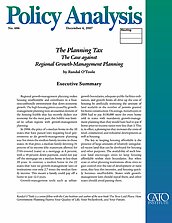In 2006, the price of a median home in the 10 states that have passed laws requiring local governments to do growth-management planning was five times the median family income in those states. At that price, a median family devoting 31 percent of its income (the maximum allowed for FHA-insured loans) to a mortgage at 6 percent, with a 10 percent down payment, could not pay off the mortgage on a median home in less than 59 years. In contrast, a median home in the 22 states that have no growth-management laws or institutions cost only 2.7 times the median family income. This meant a family could pay off a home in just 12.5 years.
Growth-management tools such as urban-growth boundaries, adequate-public-facilities ordinances, and growth limits all drive up the cost of housing by artificially restricting the amount of land available or the number of permits granted for home construction. On average, homebuyers in 2006 had to pay $130,000 more for every home sold in states with mandatory growth-management planning than they would have had to pay if home price-to-income ratios were less than 3. This is, in effect, a planning tax that increases the costs of retail, commercial, and industrial developments as well as housing.
The key to keeping housing affordable is the presence of large amounts of relatively unregulated vacant land that can be developed for housing and other purposes. The availability of such low-cost land encourages cities to keep housing affordable within their boundaries. But when state or other planning institutions allow cities to gain control over the rate of development of rural areas, they lose this incentive, and housing quickly becomes unaffordable. States with growth-management laws should repeal them, and other states should avoid passing them.


